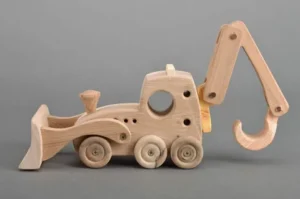The Timeless Appeal of Wooden Toys
Picture this: a child’s eyes light up as they run their fingers along the smooth surface of a wooden block, their imagination igniting with endless possibilities. This scene, timeless and universal, captures the essence of why wooden toys have been cherished for generations. In an age of flashy gadgets and digital distractions, these simple, natural playthings continue to hold a special place in childhood development.

A Personal Journey into the World of Wooden Wonders
As a parent and childhood development enthusiast, I vividly remember the day I first introduced my daughter to a set of wooden blocks. It was a stark contrast to the noisy, battery-operated toys that had dominated her playroom. To my surprise, she was instantly captivated. Hours flew by as she stacked, sorted, and created, her concentration unwavering. It was then that I realized the profound impact these unassuming toys could have on a child’s growth.
The Benefits of Wooden Toys: More Than Meets the Eye
1. Sensory Stimulation
wooden toy engage multiple senses simultaneously. The weight, texture, and even the subtle scent of wood provide a rich sensory experience that plastic toys simply can’t match. This multisensory play is crucial for developing neural connections in young minds.
2. Creativity and Imagination
Unlike toys with predetermined functions, wooden toys are open-ended. A wooden block can be a castle tower one moment and a racing car the next. This flexibility nurtures creativity and encourages children to think outside the box.
3. Fine Motor Skills Development
Manipulating wooden toys requires precise movements, helping children refine their fine motor skills. Whether it’s threading wooden beads or fitting pieces of a puzzle together, these activities lay the foundation for future skills like writing and tying shoelaces.
4. Cognitive Growth
Wooden toys often involve problem-solving elements. Puzzles, shape sorters, and building sets challenge children’s minds, promoting logical thinking and spatial awareness. These cognitive benefits extend far beyond playtime, supporting academic learning in later years.
Addressing the Counterarguments
Some might argue that wooden toys lack the excitement of their electronic counterparts. However, this simplicity is precisely their strength. Without flashing lights and pre-programmed sounds, children are free to create their own narratives and sound effects, fostering language development and storytelling skills.
Others may point out the higher cost of quality wooden toys. While it’s true that they can be more expensive upfront, their durability means they often outlast plastic alternatives, potentially being passed down through generations. Moreover, their timeless design means they don’t quickly become “outdated” in a child’s eyes.
The Environmental Angle
In our increasingly eco-conscious world, wooden toys offer a sustainable alternative to plastic. Many are made from responsibly sourced wood and finished with non-toxic paints, aligning with the values of environmentally-minded parents. This aspect adds another layer of educational value, introducing children to concepts of sustainability from an early age.
A Look to the Future
As we navigate an increasingly digital world, the role of wooden toys becomes even more significant. They offer a tangible, “real-world” play experience that balances screen time and provides a much-needed connection to nature. The skills developed through wooden toy play – creativity, problem-solving, and fine motor control – are precisely the skills that will remain relevant in an automated future.
Conclusion: The Enduring Magic of Wood
In conclusion, wooden toys are far more than simple playthings. They are tools for growth, creativity, and learning. As we look to nurture the next generation, perhaps it’s time to take a step back from the complexity of modern toys and embrace the elegant simplicity of wood. In doing so, we might just unlock a world of developmental benefits that have stood the test of time.
The next time you see a child engrossed in play with a wooden toy, take a moment to appreciate the learning and growth happening before your eyes. In that simple act of play lies the foundation for a lifetime of learning, creativity, and wonder. After all, isn’t that what childhood is all about?

